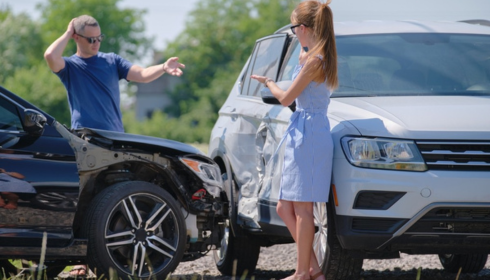Yes. Victims often need a Richmond car accident attorney after a T-bone collision because these crashes usually cause serious injuries and disputed liability. An attorney investigates the accident, gathers time-sensitive evidence, and counters insurer tactics under Virginia’s strict contributory negligence law. Without legal help, victims risk losing compensation for medical bills, lost wages, and long-term care, even when the other driver’s negligence clearly caused the crash.
Side-impact crashes, also called T-bone collisions, are among the most dangerous types of car accidents on Richmond’s roads. The impact concentrates on one side of the vehicle, often with little structural protection for passengers. Victims may face spinal cord injuries, internal bleeding, or brain trauma even at moderate speeds. Beyond the physical injuries, T-bone crashes also create legal complications. Questions about red lights, stop signs, or right-of-way often spark disputes that delay compensation.
What Evidence Should You Gather After a T-Bone Accident in Richmond?
Evidence forms the backbone of any car accident claim. In a T-bone collision, where liability often depends on traffic signals and driver behavior, detailed proof makes the difference between a denied claim and fair compensation. Start by collecting photographs of both vehicles, their positions after the crash, skid marks, and surrounding road conditions.
Capturing weather, lighting, and visibility at the time of the accident also strengthens your case. If traffic signs, lights, or lane markings are nearby, include them in your photos. Obtain the official police report and online report of the accident, which provides an independent record of the crash. Officers typically document the driver’s statements, witness accounts, and determine whether traffic laws were violated. This record serves as robust evidence in court or during settlement negotiations.
Medical documentation is equally important. Keep records of emergency care, diagnostic scans, prescriptions, and rehabilitation plans to ensure continuity of care. Linking your injuries directly to the crash helps counter insurance arguments that your condition was pre-existing or caused by something else. Other critical evidence may include:
- Emergency response reports from EMTs or firefighters.
- Vehicle black box data, which records speed, braking, and impact forces.
- Traffic camera or intersection surveillance footage.
- Cell phone records showing whether the at-fault driver was texting.
- Witness testimony from pedestrians, cyclists, or nearby business owners.
Many of these records are time-sensitive. Black box data can be erased within days, and intersection footage may only be stored for a short period. Preserving this evidence quickly often requires legal intervention, especially if subpoenas are necessary.
Why Is Immediate Medical Attention Important After a Side-Impact Collision?
T-bone accidents can cause devastating injuries, even when vehicles collide at lower speeds. The lack of side protection compared to the front or rear of a car makes passengers more vulnerable. Unlike frontal crashes, where airbags and crumple zones absorb much of the force, side-impact collisions transfer energy directly into the vehicle’s cabin. This often results in severe trauma to the head, chest, spine, and pelvis, even when seatbelts and airbags function properly. Common injuries include:
- Spinal cord injuries may lead to partial or complete paralysis.
- Traumatic brain injuries (TBI) from sudden head movements or impact.
- Internal bleeding and organ damage, which may not be visible right away.
- Fractures and orthopedic injuries in the ribs, pelvis, and legs.
The danger is that many of these injuries do not show immediate symptoms. Internal bleeding, for example, can develop over hours, while concussions may take days to reveal full effects. Seeking prompt medical attention ensures early diagnosis and prevents conditions from becoming life-threatening.
From a legal standpoint, early medical care also strengthens your claim. Insurers often argue that delays in treatment mean injuries were unrelated to the crash. Medical records from the hours and days after the accident directly tie your condition to the collision, making it harder for insurers to dispute liability.
When Should You Consult a Richmond T-Bone Accident Attorney?
Not every minor collision requires legal help, but T-bone accidents often cause severe injuries and disputed liability. You should consult an attorney if you face high medical expenses, long-term treatment, lost wages, or when insurers delay or challenge valid claims.
- Your injuries require hospitalization, surgery, or long-term rehabilitation.
- You experience lost wages, reduced earning capacity, or job loss.
- The insurance company disputes liability or delays processing your claim.
- You face significant future medical expenses.
Virginia follows a strict contributory negligence rule. This means if you are found even 1% at fault for the crash, you may be barred from recovering compensation. Insurers often exploit this rule, looking for any detail like a slight rolling stop or distracted glance that could shift partial blame onto you.
A Richmond car accident lawyer investigates the crash thoroughly to prove the other driver’s sole responsibility. By analyzing traffic light patterns, securing witness testimony, and working with accident reconstruction experts, attorneys build strong cases that withstand insurer challenges.
Can Local Witnesses in Richmond Strengthen Your Claim?
Independent witnesses add credibility that can shift the outcome of a case. In Richmond, pedestrians near intersections, other drivers, or even local business employees may have seen the crash unfold. Their statements can confirm critical details, such as whether the at-fault driver ran a red light, failed to yield, or appeared distracted by a phone.
Witnesses provide unbiased testimony that insurers and courts view as reliable. Unlike passengers in your vehicle, they do not have a direct financial interest in your claim. This makes their observations more persuasive when liability is disputed.
In some cases, business owners or employees from nearby establishments have surveillance cameras that captured the accident. This combination of visual evidence and live testimony can be instrumental in proving fault.
Why Should You Avoid Early Statements to the Insurance Company?
After a T-bone accident, insurance adjusters may call quickly, requesting a recorded statement. Although it may appear routine, their true goal is to protect the insurer’s financial interests, not your recovery. These statements are often used to shift blame or minimize the amount of compensation.
Adjusters use carefully worded questions to get you to admit partial fault or downplay your injuries. Even casual remarks like “I’m feeling better today” can later be used to argue that your injuries were minor. Quick settlement offers are another tactic, pushing victims to accept compensation before the full extent of their injuries is known. Here’s how early statements may be used against you:
- They can resurface during settlement talks or at trial.
- Insurers may use them to dispute the severity of your injuries.
- They may lock you into an incomplete version of events before evidence is available.
Since accident reconstruction, medical records, and expert reports take time to develop, providing a statement too early can seriously weaken your claim. Allowing your attorney to handle communications with insurers protects your rights and prevents costly mistakes.
How Do Structured Settlements Support Recovery After a T-Bone Crash?
For victims with catastrophic or long-term injuries, a structured settlement can provide lasting financial security. Rather than a single lump-sum payout, compensation is delivered through scheduled payments over months or years, ensuring steady income to cover medical care, rehabilitation, and daily living expenses. This predictable stream of funds can be significant when victims face lifelong treatment needs and uncertain employment prospects after a serious crash.
- Steady income to cover ongoing medical and household costs.
Structured settlements ensure victims are never left scrambling to pay essential bills. From therapy appointments to medication refills and even monthly rent or utility costs, these payments create stability. For families already under emotional strain, knowing that financial support will arrive consistently each month relieves added stress and allows them to focus on healing.
- Protection for minors or victims with permanent disabilities.
When a child or disabled adult is injured in a T-bone accident, structured settlements protect against early depletion of funds. Payments are safeguarded and managed responsibly, ensuring that victims are provided with financial resources as they age or as their medical needs evolve. This security prevents settlement money from being misused or exhausted too soon.
- Tax-free payments under federal law.
Unlike other income sources, structured settlement payments are exempt from federal income taxes. This means every dollar goes directly toward recovery and living expenses, maximizing the value of the compensation. Over time, this tax-free advantage can save victims and their families thousands of dollars while ensuring that financial support stretches further into the future.
- Flexibility to schedule larger payments for future needs, like surgeries.
Structured settlements can be designed with life’s unpredictable challenges in mind. Victims may arrange for smaller monthly payments to handle routine expenses, while scheduling larger lump sums to coincide with anticipated surgeries, specialized treatments, or the purchase of adaptive equipment. This tailored flexibility makes structured settlements a practical solution for long-term planning after devastating crashes.
This system reduces the risk of exhausting settlement funds too quickly and provides stability as victims rebuild their lives. According to the National Structured Settlements Trade Association (NSSTA), structured payments prevent financial hardship and ensure resources remain available for long-term care. For T-bone crash survivors, this financial structure can mean the difference between struggling to stay afloat and confidently securing their recovery journey.
What Are the Most Common Injuries in Richmond T-Bone Collisions?
T-bone crashes often result in more severe injuries than rear-end or head-on accidents because the sides of vehicles offer minimal structural protection. The sudden lateral force can crush doors inward, shatter windows, and expose occupants to direct impact, leading to some of the most serious collision-related injuries.
- Head trauma and concussions from striking windows or airbags.
- Chest injuries, including broken ribs and lung damage.
- Hip and pelvic fractures from direct impact at the door.
- Whiplash and neck injuries are caused by sudden sideways motion.
- Lacerations from shattered glass or crushed vehicle structures.
These injuries often require extensive treatment, ranging from emergency surgery to months of rehabilitation. In catastrophic cases, victims may face permanent disability, limiting their ability to work or enjoy daily life.
A Richmond attorney ensures settlement negotiations account for both immediate and long-term needs. This includes covering current medical expenses as well as projected future costs, such as rehabilitation, therapy, adaptive equipment, in-home nursing care, and other expenses that often follow severe T-bone collisions.
FAQs
Are medical bills covered right away under Virginia insurance?
Virginia follows an at-fault system, so the at-fault driver’s insurance typically pays damages. However, victims often rely on MedPay or personal health insurance first, then pursue reimbursement later. This process ensures treatment begins immediately despite potential delays in liability resolution.
Is documenting weather and road conditions necessary?
Yes. Weather and road conditions help reconstruct how the accident occurred, but they do not excuse negligence. Recording details like rain, fog, or icy pavement provides context, supports accident reconstruction, and strengthens claims when insurers challenge responsibility or liability for damages.
How long does it take to obtain a Richmond crash report?
Crash reports are usually available within seven to ten days from the Virginia DMV or Richmond Police Department. These official records provide critical details on citations, driver behavior, and witnesses, making them essential for supporting both insurance claims and legal cases.
Do passengers have the right to file claims?
Yes. Injured passengers may pursue compensation against the at-fault driver’s insurance, regardless of whether they were riding with the negligent driver or another motorist. They can recover for medical treatment, pain, lost income, and other accident-related financial and personal damages.
Can I still recover damages if I was partly at fault?
Virginia applies strict contributory negligence. If you are found even one percent at fault, recovery may be barred completely. This harsh rule makes legal representation vital, since attorneys focus on proving the other driver’s total responsibility for the crash.
What damages can be recovered in a Richmond T-bone accident case?
Damages may include medical bills, lost wages, reduced earning ability, property damage, pain and suffering, and wrongful death compensation. Families may also pursue funeral costs and loss of companionship, ensuring both economic and non-economic losses are fully addressed in claims.
How long do T-bone accident cases take to resolve?
Resolution time depends on case complexity. Some claims settle within months, while disputes over liability, medical recovery, or insurer cooperation may extend cases for years. Serious injury claims often require detailed investigation and expert input, leading to longer settlement timelines.
Take Control of Your Recovery After a Richmond T-Bone Collision
After a side-impact crash, you deserve more than just medical care; you deserve financial protection and peace of mind. T-bone accidents often leave victims struggling with steep hospital bills, lost income, and insurers looking for ways to deny responsibility. With the strict contributory negligence laws in Virginia, even a small detail could put your right to compensation at risk. Having the proper advocate levels the playing field.
A Richmond car accident attorney can guide you through every step, from gathering evidence to negotiating with insurers who try to minimize payouts. Instead of facing this stressful process alone, you gain a partner committed to protecting your rights and securing the resources you need for medical treatment, rehabilitation, and daily living. Taking action now ensures your future remains steady, even after the sudden chaos of a T-bone collision.



